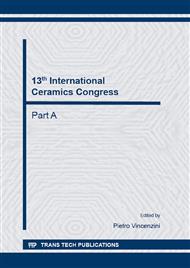p.1
p.6
p.12
p.18
p.24
p.30
p.36
p.42
Structural and Electrical Properties of (1-x)Pb (Zry Ti1-y)O3-xSm(Fe3+0.5, Nb5+0.5)O3 Ceramics Prepared by Conventional Solid State Synthesis and Sintered at Low Temperature
Abstract:
The phase structure, microstructure and electrical properties of (1-x)Pb (Zry Ti1-y)O3-xSm(Fe3+0.5, Nb5+0.5)O3 (PZT–SFN) (with x = 2 %, 41%≤ y ≤57 %) piezoelectric ceramics were prepared by the conventional solid state method, and effects of SFN and the Zr/Ti ratio content on the piezoelectric properties of PZT ceramics were mainly investigated. A stable solid solution has been formed between PZT and SFN, and a morphotropic phase boundary of PZT–SFN ceramics is identified in the range of 51% ≤ y ≤55 %. The Curie temperature of PZT–SFN ceramics decreases with increasing at Zr/Ti ratio content. A higher εr value and a lower tanδ value are demonstrated for the PZT–SFN ceramics with y = 53 %. The PZT–SFN ceramics with y = 53 % has an enhanced electrical behavior of kp ~ 61.2 %, Qm ~ 104, εr ~ 566, tanδ ~ 2.02 % and TC ~ 370 OC. As a result, PZT–SFN ceramics are promising candidate materials for the field of lead piezoelectric materials and piezoelectric device.
Info:
Periodical:
Pages:
12-17
Citation:
Online since:
October 2014
Authors:
Price:
Сopyright:
© 2014 Trans Tech Publications Ltd. All Rights Reserved
Share:
Citation:


